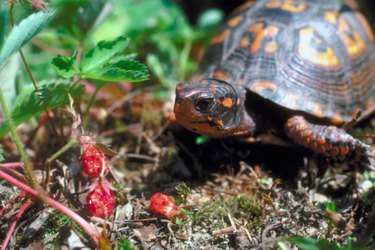
Many red berries grow in the wild and it's important to know which ones are edible. Some wild, red berries are inedible simply because of their taste, while others may cause health problems and even death. Wild berries thrive in sun or shade, meadows or forests, and even in your own backyard. Whether you have small children or ever have occasion to rely on wild plants for survival, know your wild, red berries.
Edible Rosaceae Family
Video of the Day

The rose family -- Rosaceae -- contains species that produce edible berries. One species is wood strawberry -- Fragaria vesca -- which resembles the much larger commercially-grown strawberry, but takes longer to gather. The fruit is edible and some even say better tasting. Found in rarely cleared areas, this wild berry grows on long runners along the ground. Wild rose vines produce small red rose hips that are high in Vitamin C.
Video of the Day
Edible Ericaceae Family

The Ericaceae – Heath family – contains many varieties of edible, red berries. One is red huckleberry – Vaccinum parvifolium. This edible berry produces small, tart fruit from late June through September. Red huckleberry plants grow on stumps and other decaying wood. Whortleberry is a low shrub that grows wild in Scandinavia and Poland. Eat this fruit right off the bush or use these berries in jam and pies.
Inedible Varieties

Holly bushes, with their spiky and glossy green leaves, produce red berries that can cause health problems if more than three are ingested. These berries cause severe gastric upset and sometimes sleepiness. This evergreen shrub is popular in home landscaping which makes it a frequent problem for families with small children. Plant away from homes for child safety. Bitter cherry – Prunus emarginata – produces translucent, red berries with large pits from late May through the month of June. Bitter cherry berries grow on a small tree with a slender trunk that reaches less than 30 feet tall. Bitter cherry trees produces small, white flowers in clusters of five to 12 and can be identified by its dark grayish bark that has horizontal banding.
Poisonous Red Berries

Thriving in the moist woods of North America, Asia and Europe, red baneberry – Actaea rubra -- is commonly referred to as red cohosh or necklaceweed. This berry species sprouts small, white flowers that give off a rose-like fragrance and its fruit grows low to the ground among toothed, glossy leaves. Red baneberry is deadly poisonous. Less deadly, but known to cause respiratory, nervous system, and cardiac problems, red nightshade – Solanum dulcamara – produces oval leaves on a creeping vine. Blooming with hanging purple flowers from May to December, red nightshade berries can be confused with small red cherry tomatoes. Though this berry is normally causes systemic problems; it can be deadly in some cases.